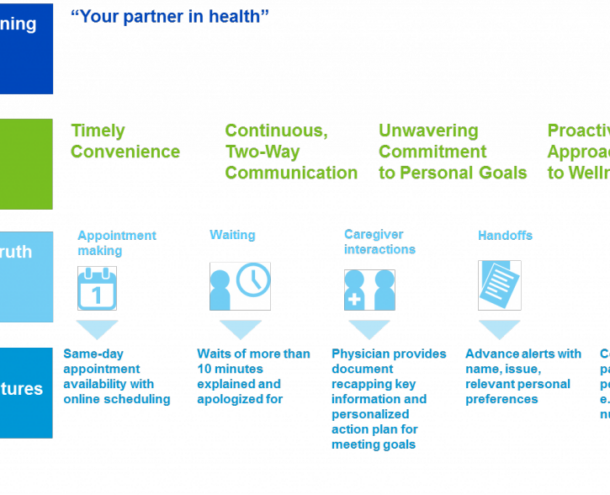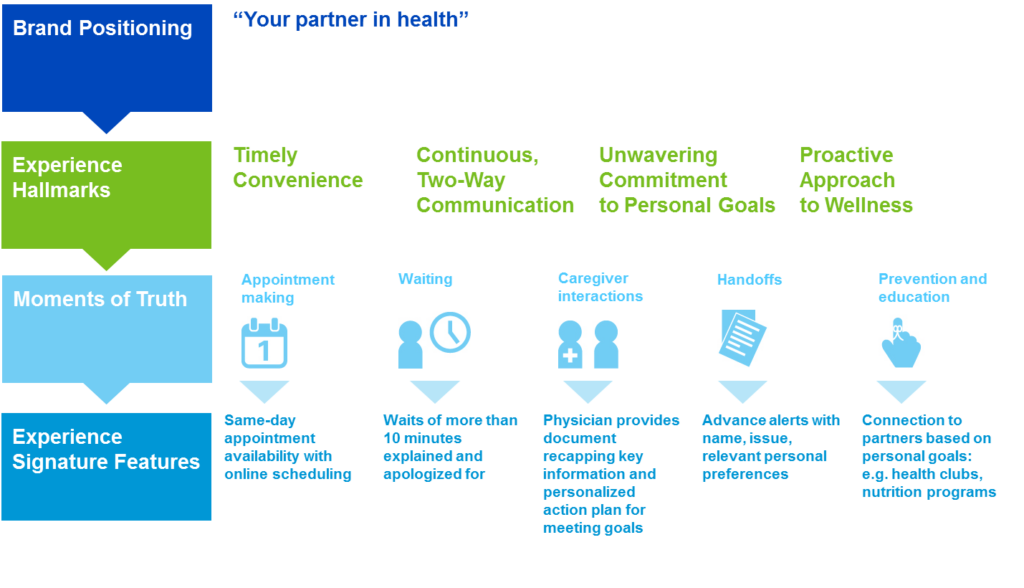Unlock the Potential of Your Health Care System Brand

Not long ago, health care system brands could set themselves apart by defining their “system” story. It was all about creating awareness of a system’s component parts, and claiming size and scale as audience benefits. Organizations connected entities to increase the reach and scope of their services, while ensuring that the brands were visually aligned. While it was more cohesive than previous approaches, this method was essentially a linkage strategy rather than a true branding strategy.
In today’s increasingly complex and competitive health care environment, the traditional system branding approach needs to go further. Success these days requires “synergy branding”―an approach that goes much deeper in order to define the whole as more than the sum of its component parts.
Three Core Principles Drive Synergy Branding
Embed

Defining the brand strategy and aligning visual and verbal expression are critical first steps, but true value creation requires applying brand much more broadly. An organization’s top leaders must be visible champions who use brand as a filter to drive decision making across every aspect of the business, from HR to Operations and beyond.
Banner Health has built its powerhouse brand through this approach, embedding the attributes of clinical excellence and innovation across the organization. Clinical leaders made Banner the first system in the Western U.S. to use an intelligent OB program to provide clinical decision support, documentation, and monitoring to help reduce complications during childbirth. Applying the concepts of clinical excellence and innovation to employee training, Banner created the nation’s first complete-care simulation hospital: a 55,000-square-foot virtual hospital and orientation program.
Empower

Synergy thrives in an environment that empowers employees to live the brand. Employees must understand the brand’s role, value, and relevance to the organization’s key audiences and to themselves, and they must be equipped and motivated to deliver on it. Scripps Health does a masterful job of ensuring that each employee has a clear line of sight between his or her role and the Scripps brand promise, “Excellence All Around You.”
To Scripps’ employees, brand is not “a marketing thing”―it’s a promise that they own. Hear Christine Clay, Senior Director of Brand Strategy and Marketing, speak about how Scripps creates this line of sight, at the most recent Society for Health Care Strategy and Market Development (SHSMD) conference.
Experience

The last component of synergy branding involves delivering a meaningful, coordinated, and differentiated experience at every touchpoint. Success requires both science and art: the science of gathering and analyzing data to understand what drives engagement, behavior, and choice; the art of connecting emotionally through inspiring, compelling, connected―and sometimes unexpected―experiences.
Customer journey mapping is a great tool for aligning experience with brand. Here are the steps:
- Identify your brand promise or positioning, such as “Your partner in health” as shown below.
- Apply the idea to create experience hallmarks that describe the key characteristics of an on-brand experience.
- Think through the audience’s journey with your brand in mind and identify the points of contact that are most important to each one. These “moments of truth” are where you have the greatest potential to either exceed expectations or create disappointment―so they are the best opportunities for creating a differentiated experience.
- Focusing on these touchpoints, identify signature features your brand can become known for. Determine who from other functional areas (e.g. Operations, Patient Experience, HR) needs to be involved to deliver the features.
- Identify any potential barriers and work with your counterparts from the other areas to ensure the experience is consistently delivered.
 As the health care industry continues to transform, systems that apply synergy branding to unlock their brands’ potential will gain a powerful competitive advantage.
As the health care industry continues to transform, systems that apply synergy branding to unlock their brands’ potential will gain a powerful competitive advantage.
To learn more about health care system branding visit our website.
Lynne Field is the Client Service Practice Lead and a Senior Strategy Director at Monigle.


